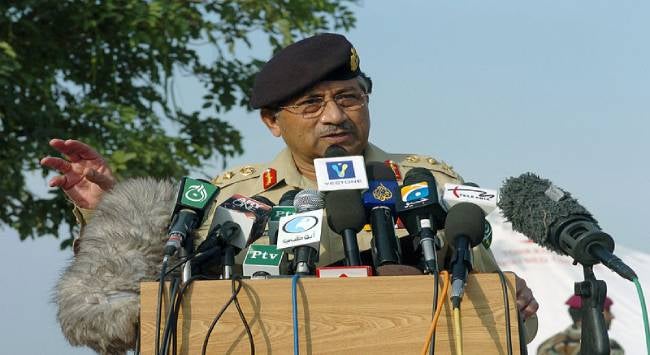Summary
The mechanics of General Pervez Musharraf’s authoritarianism share a close semblance to the strategies of political manipulations of Pakistan’s previous dictators, Ayub Khan and Muhammad Zia-ul-Haq. However, aspects of constitutional change, expansion of the media and a significant shift in the public discourse towards the establishment are notable and enduring features of a post-Musharraf Pakistan. His ambivalence towards Islamist militants and state repression towards the aggrieved have left the country more divided and more fractious than before.
General Pervez Musharraf’s passing in early February 2023 has provoked much reflection and discussion concerning the legacies of his regime. Musharraf assumed power by overthrowing Nawaz Sharif’s Pakistan Muslim League (PML) government, declaring a state of emergency across the country, taking over the office of the Chief Executive, placing the constitution into abeyance and suspending parliament and the provincial assemblies. His televised address on 17 October 1999 assured the nation that ‘‘this is not martial law, only another path towards democracy…for true democracy”. He stressed the importance of rebuilding national, economic and institutional confidence in order to “save the nation”. While his speech emphasised accountability in the fight against corruption, the Provisional Constitution Order (No. 1 of 1999) which followed ensured that Musharraf himself could not be held accountable whatsoever for his actions as Chief Executive.
Musharraf attempted to control the courts, use constitutional manipulation to perpetuate his power, carry out regular political interventions through ordinances, build a political class at the level of local government to undermine provincial governments and orchestrate the theatre of electoral processes to garner democratic legitimacy. The mechanics of his authoritarianism share a close semblance to the strategies and political manipulations of Pakistan’s previous dictators, Ayub Khan and Muhammad Zia-ul-Haq. However, there are also notable departures. He found some success in improving bilateral relations with India and remained instrumental in producing a framework to settle longstanding tensions between the two countries over Jammu and Kashmir. But whether Musharraf himself actually believed that India and Pakistan could hold to lasting, viable and peaceful relations is another matter. In his memoir, In the Line of Fire, he writes, “Why did India acquire nuclear, and later missile, capability? Quite clearly, it had grandiose ambitions of projecting its power regionally and even globally and achieving hegemony over the Gulf and in south Asia and southeast Asia.” In any case, despite his efforts, progress on the peace process stalled as his hold on power waned. However, Raja Mohan, a leading analyst of India’s foreign policy, points outs, past negotiations provide “a sensible basis for picking up the threads of the India-Pakistan peace process at some point”.
Musharraf was also credited with the expansion of the media landscape in Pakistan which, prior to his coup, was largely dominated by state-owned enterprises and a select, but influential, set of privately-owned print media outlets. Under Musharraf, FM radio, television stations and cable-television providers flourished, while mobile-phone and internet usage also increased. However, the liberalisation of electronic media had decidedly political objectives since Musharraf hoped to harness their anti-PML and anti-Pakistan Peoples Party sentiments. He was quick to clamp down on media freedoms when it ultimately threatened his rule. The headlines of state repression, censorship, the curtailing of political activity, suppression of his political opponents and disturbing details of enforced disappearances under the cover of the United States-led war on terror spoke in stark contrast to the public image of the progressive, modern liberal Pakistan that Musharraf had tirelessly struggled to cultivate through his writings, speeches and interviews. The media, as news editor, Najam Sethi, explains, “ended up being a knife in his back”.
While the passing of the 18th Amendment in 2010 followed a familiar pattern of constitutional reform in post-authoritarian democratic interregnums (aimed at effacing the authoritarian imprint from the country’s constitution), this amendment was striking in its explicit description of the crime of high treason in Article 6 as anyone who abrogates or subverts or suspends or holds in abeyance, or attempts or conspires to abrogate or subvert or suspend or hold in abeyance, the constitution by use of force or show of force or by any other unconstitutional means. Article 6 further proclaimed that the Supreme Court or a High Court could not validate an act of high treason. At least in principle, it laid down a glaring (legal) signpost for boundaries in civil-military relations. That Musharraf was sentenced to death on the charge of high treason indicates an unprecedented shift from deference and silence to open, public and frequent criticism of the security establishment – something which his own designs of liberalising the media had undoubtedly contributed towards.
Finally, Musharraf’s double game of dividing between good and bad militants during the war on terror continues to haunt Pakistan as the country reels from the mounting force of violent Islamist radicalism. He is also held responsible for laying the foundations for the insurgency in Balochistan which continues to today by responding to Baloch grievances with state repression and gross violations of human rights. With ambivalence towards the militants and state repression towards the aggrieved, Musharraf hardened precedents and patterns from the security establishment has been unable or unwilling to escape. He leaves Pakistan more divided and more fractious than before.
. . . . .
Dr Imran Ahmed is a Research Fellow at the Institute of South Asian Studies (ISAS), an autonomous research institute in the National University of Singapore (NUS). He can be contacted at iahmed@nus.edu.sg. The author bears full responsibility for the facts cited and opinions expressed in this paper.
Pic Credit: Wikipedia Commons
-
 More From :
More From :
-
 Tags :
Tags :
-
 Download PDF
Download PDF



